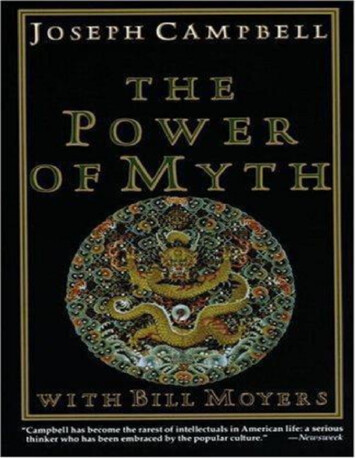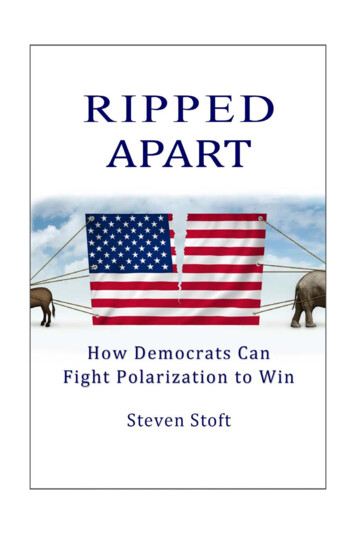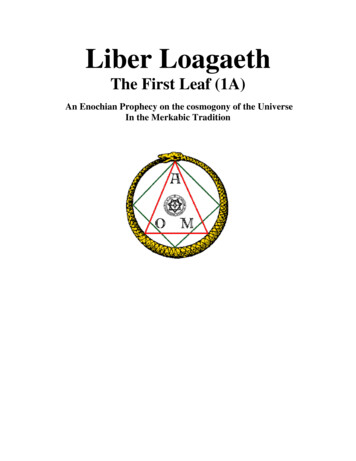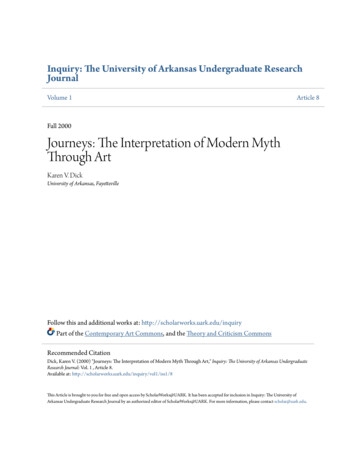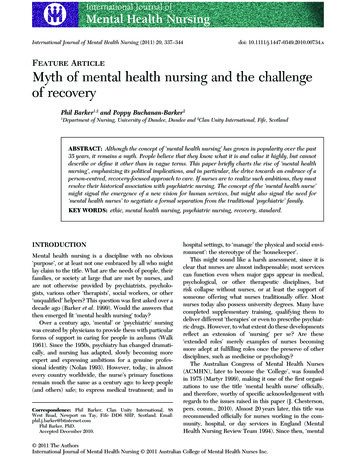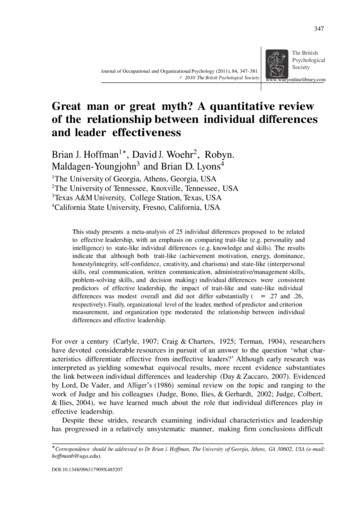
Transcription
347Journal of Occupational and Organizational Psychology (2011), 84, 347–381C 2010 The British Psychological SocietyThe comGreat man or great myth? A quantitative reviewof the relationship between individual differencesand leader effectivenessBrian J. Hoffman1 , David J. Woehr2 , Robyn.Maldagen-Youngjohn3 and Brian D. Lyons41The University of Georgia, Athens, Georgia, USAThe University of Tennessee, Knoxville, Tennessee, USA3Texas A&M University, College Station, Texas, USA4California State University, Fresno, California, USA2This study presents a meta-analysis of 25 individual differences proposed to be relatedto effective leadership, with an emphasis on comparing trait-like (e.g. personality andintelligence) to state-like individual differences (e.g. knowledge and skills). The resultsindicate that although both trait-like (achievement motivation, energy, dominance,honesty/integrity, self-confidence, creativity, and charisma) and state-like (interpersonalskills, oral communication, written communication, administrative/management skills,problem-solving skills, and decision making) individual differences were consistentpredictors of effective leadership, the impact of trait-like and state-like individualdifferences was modest overall and did not differ substantially ( .27 and .26,respectively). Finally, organizational level of the leader, method of predictor and criterionmeasurement, and organization type moderated the relationship between individualdifferences and effective leadership.For over a century (Carlyle, 1907; Craig & Charters, 1925; Terman, 1904), researchershave devoted considerable resources in pursuit of an answer to the question ‘what characteristics differentiate effective from ineffective leaders?’ Although early research wasinterpreted as yielding somewhat equivocal results, more recent evidence substantiatesthe link between individual differences and leadership (Day & Zaccaro, 2007). Evidencedby Lord, De Vader, and Alliger’s (1986) seminal review on the topic and ranging to thework of Judge and his colleagues (Judge, Bono, Ilies, & Gerhardt, 2002; Judge, Colbert,& Ilies, 2004), we have learned much about the role that individual differences play ineffective leadership.Despite these strides, research examining individual characteristics and leadershiphas progressed in a relatively unsystematic manner, making firm conclusions difficult Correspondence should be addressed to Dr Brian J. Hoffman, The University of Georgia, Athens, GA 30602, USA 5207
348Brian. J. Hoffman et al.(House & Aditya, 1997; Zaccaro, 2007). Indeed, in a recent review of the state of theindividual differences–leadership literature, Zaccaro (2007) noted one of the primarybarriers to progress in this stream of research is the lack of a ‘coherent and meaningfulconceptual construction’ (p. 6). Given the complexity of leadership, an additionallimitation of existing research is the use of frameworks that are ‘limited in theirelucidation of central leader attributes’ (Zaccaro, 2007, p. 6). This trend is reflected inprevious meta-analyses, which have focused exclusively on relatively narrow categoriesof individual differences (e.g. the ‘Big Five’ personality dimensions or intelligence). Giventhe proliferation of research examining individual differences over the last three decades,the somewhat narrow scope of prior meta-analyses, and the fragmented nature of theliterature, the picture is still somewhat unclear with respect to the impact of individualdifferences on effective leadership (House & Aditya, 1997; Zaccaro, 2007).In an attempt to organize this fragmented literature, a variety of conceptual frameworks have been forwarded in recent years (e.g. Bass, 1990; Day & Zaccaro, 2007;Kirkpatrick & Locke, 1991; Locke, 1991; Mumford, Zaccaro, Harding, Owen Jacobs, &Fleishman, 2000; Yukl, 2006; Yukl & Van Fleet, 1992; Zaccaro, 2007; Zaccaro, Kemp,& Bader, 2004). One central aspect to many modern frameworks is the distinctionbetween trait-like and state-like individual difference correlates of effective leadership(Chen, Gully, Whiteman, & Kilcullen, 2000; Kirkpatrick & Locke, 1991; Locke, 1991;Yukl, 2006; Zaccaro, 2007). Following from the ‘Great Man1 ’ perspective of leadership(Carlyle, 1907), the majority of prior individual-difference oriented leadership researchemphasized dispositional precursors (referred to as trait-like/distal individual differences)of effective leadership, a trend further reflected in recent meta-analyses’ focus on traitlike individual differences (Judge et al., 2002, 2004). Diverging from the historicalemphasis on dispositional characteristics associated with the Great Man approach toleadership, recent research has shifted focus to state-like individual differences, usuallyin the form of knowledge and skills (Yukl & Van Fleet, 1992). A key distinction inthese two perspectives is that research on state-like individual differences does notpresume that the characteristics that distinguish effective from ineffective leadersare stable through the life-span. Importantly, although these two approaches havebecome a staple of modern leadership frameworks, empirical research on trait-likeand state-like approaches has largely run in parallel, with few attempts at empiricalintegration.Accordingly, the present study adopts a framework specifying both trait-like andstate-like constructs in order to facilitate a meta-analysis of the role of individualdifferences in effective leadership. In doing so, this study contributes to the literatureby: (a) using a coherent conceptual framework (House & Aditya, 1997; Zaccaro,2007), (b) specifying a wide range of individual differences (Zaccaro, 2007), and (c)comparing the role of trait-like and state-like individual differences (Kirkpatrick & Locke,1991; Locke, 1991; Mumford et al., 2000; Yukl, 2006; Zaccaro, 2007; Zaccaro et al.,2004). Specifically, we extend research on individual difference correlates of effectiveleadership by systematically examining the magnitude of the relationship between leadereffectiveness and 25 individual differences, including 14 individual differences that havenot been the subject of a meta-analytic review. Because effectiveness is arguably the most1 The term ‘GreatMan’ is used in reference to the historical line of research that considers the dispositional determinants ofeffective leadership. Because this theory has been historically referred to as the ‘Great Man’ theory of leadership, we retainedthis term in describing this line of research.
Leader traits, meta-analysis 349organizationally relevant outcome associated with leadership and has enjoyed the mostresearch attention, this review focuses only on effective leadership, rather alternativeoutcomes (e.g. leader emergence and follower job satisfaction).Trait-like and state-like individual differencesHistorically referred to as the ‘Great Man’ approach to leadership, attempts to substantiatethe dispositional components of leadership have persisted for almost as long as socialscientists have attempted to measure individual differences (Galton, 1869). Underlyingthis research is the assumption that there are heritable traits that distinguish leadersfrom non-leaders (Day & Zaccaro, 2007). From this perspective, leaders are born, notmade. Although this research fell out of favour for a time amid questions as to theevidentiary basis underlying disposition–leadership associations (Stogdill, 1948), recentyears have seen a resurgence in the investigation of the relationship between trait-likeindividual differences and effective leadership (cf. Judge et al., 2002, 2004). In contrastto prior leadership–individual difference research focusing primarily on dispositionalantecedents of effective leadership, recent conceptual models have expanded theirtreatment beyond traditional, trait-like individual differences to include proximal,malleable individual differences. Although this distinction has taken many forms using avariety of terms, including trait-like versus state-like (Chen et al., 2000; Zaccaro, 2007),proximal versus distal individual differences (Zaccaro, 2007), stable versus malleableindividual differences (Day & Zaccaro, 2007), and traits versus skills (Kirkpatrick &Locke, 1991; Locke, 1991; Yukl, 2006; Yukl & Van Fleet, 1992), these conceptions havesimilar underlying themes.A central similarity is the depiction of trait-like individual differences as havingan indirect effect on leader effectiveness, whereas state-like constructs have a moredirect effect on performance. For instance, Mumford et al. (2000), Yukl (2006), andZaccaro (2007) propose leader ‘trait’ models in which state-like individual differences,such as oral communication skills are more proximal to outcomes, whereas trait-likeindividual differences, such as extraversion, impact effective leadership through theirmore proximal counterparts. From this perspective, one reason for the frequentlydocumented modest impact of individual differences on effective leadership is thehistorical emphasis on more distal, trait-like individual differences, rather than moredirectly related, state-like individual differences. Given that variables with more directpaths have stronger relationships with criterion variables, this perspective impliesstronger correlations for more proximal, state-like measures and effective leadership,relative to more distal, trait-like measures.An additional common element is the presumption that trait-like individual differencesare less malleable than state-like individual differences (Chen et al., 2000; Day & Zaccaro,2007; Zaccaro, 2007; Zaccaro et al., 2004). When viewed in this light, the degree towhich stable versus malleable individual differences are stronger predictors of leadereffectiveness has important implications for the age old question, ‘Are leaders bornor made?’ It is in this sense that we ask the degree to which Great Man theory is agreat myth. If more proximal, state-like individual differences explain more variance ineffective leadership than more distal, trait-like individual differences, our results willindicate that effective leaders, to some degree, can be made (e.g. developed). On theother hand, a finding of a stronger effect for trait-like individual differences would implythat to some extent, ‘leadership quality is immutable and, therefore, not amenable todevelopmental interventions’ (Zaccaro, 2007, p. 6). Practically, the historical emphasis
350Brian. J. Hoffman et al.on dispositional individual differences leaves limited options for leader development –since characteristics associated with distal individual differences are assumed to bestable throughout the life-span (Day & Zaccaro, 2007). Alternatively, proximal, statelike individual differences may hold more promise for leader development, becausecharacteristics such as knowledge and skills are malleable through carefully constructeddevelopmental interventions (Mumford et al., 2000).Locke’s (1991) individual difference frameworkLocke (Kirkpatrick & Locke, 1991; Locke, 1991) presents a general framework whichlists and categorizes individual differences necessary for effective leadership. Consistentwith recent models (Day & Zaccaro, 2007; Mumford et al., 2000; Yukl, 2006; Zaccaro,2007), individual differences can be organized into two broad categories reflecting thedistinction between distal (motives, traits, and ability) and proximal (knowledge andskills) individual differences. Although a variety of conceptual models specify the rolethat individual differences play in effective leadership, Locke’s framework provides oneof the most inclusive lists of individual differences. Thus, to provide as comprehensivetreatment as possible, while working in the bounds of an existing framework (House& Aditya, 1997; Zaccaro, 2007), we primarily relied on Locke’s framework in selectingindividual differences to review. Nevertheless, there is a high degree of overlap inthe state-like and trait-like individual differences specified in Locke’s model and thoseproposed by other popular individual difference frameworks.Trait-like individual differencesWe identified 16 trait-like individual differences as precursors to effective leadership. Ofthese, 10 have been subject to prior quantitative review. Specifically, prior reviews havesupported weak to moderate relationships between leader effectiveness and: dominance(Judge et al., 2002; Lord et al., 1986); achievement (Judge et al., 2002); extraversion(Judge et al., 2002; Lord et al., 1986); and conscientiousness (Judge et al., 2002). Priormeta-analyses revealed weak, albeit consistently non-zero relationships between selfconfidence (labelled self-esteem; Judge et al., 2002) and adjustment (labelled neuroticism; Judge et al., 2002; Lord et al., 1986) and leader effectiveness. Next, voluminousresearch has investigated the impact of charisma on leader effectiveness, and multiplemeta-analytic reviews have substantiated this relationship, often reporting correlationsin excess of .5 between charisma and leader effectiveness (Judge & Piccolo, 2004;Lowe, Kroeck, & Sivasubramaniam, 1996). Finally, although prior reviews consistentlysupport a relationship between intelligence and leader effectiveness, the relationshipvaries in magnitude from modest (Judge et al., 2004) to moderate (Lord et al., 1986).Because of the strong empirical and theoretical links between these 10 individualdifferences and effective leadership, we do not provide a review of the empiricaland theoretical literature here. The interested reader is referred to prior reviews fora more in-depth treatment (Bass, 1990; House & Aditya, 1997; Judge et al., 2002,2004; Judge & Piccolo, 2004; Kirkpatrick & Locke, 1991; Locke, 1991; Lowe et al.,1996). However, the relationships between leader effectiveness and the remainingseven distal individual differences have not yet been subject to a systematic summary.Accordingly, this study contributes to the literature by providing a population estimateof the relationship between leader effectiveness and ambition, initiative, energy, needfor power, honesty/integrity, creativity, and self-monitoring.
Leader traits, meta-analysis 351A motive is defined as a relatively stable individual characteristic that energizes anddirects behaviour (cf. McClelland & Boyatzis, 1982). Previous motives not subject toreview include ambition, initiative, energy, and need for power. Ambition is defined as adesire for success with respect to career progression and work unit effectiveness (Locke,1991). Next, initiative refers to the willingness to take action by exerting additional effortto exceed expectations (Kirkpatrick & Locke, 1991). To the extent that individuals withhigh levels of ambition and initiative focus on task objectives, set challenging goals fortheir work-group, and emphasize the importance of effective performance, they areexpected to be more effective leaders (McClelland & Boyatzis, 1982). Both ambitionand initiative are commonly hypothesized by prior individual difference models (Bass,1990; Kirkpatrick & Locke, 1991; Locke, 1991; Stogdill, 1948; Yukl, 2006). Energy isdefined as a high degree of stamina and ability to maintain a high rate of activity and isfrequently hypothesized as a key determinant of effective leadership (Bass, 1990; Daft,1999; Kirkpatrick & Locke, 1991; Yukl, 2006; Yukl & Van Fleet, 1992). A leader mustmaintain a high level of energy in order to effectively perform in the face of the longhours and hectic schedule associated with leadership roles (Mintzberg, 1973). Finally,individuals with high levels of need for power are characterized by the satisfactionthey derive from exerting influence over the attitudes and behaviours of others (Gough,1969; McClelland & Boyatzis, 1982). The motive to influence is associated with seekingpositions of authority, being attuned to the political climate of the organization, and theassertiveness needed to direct group activities and advocate for desired changes to theorganization and as such, is a frequently proposed antecedent of effective leadership(House & Aditya, 1997; Locke, 1991; Yukl, 2006). These theoretical explanations aresupported by empirical work substantiating the association between ambition (Stogdill,1948), initiative (Russell & Domm, 1995), energy (Howard & Bray, 1988), and need forpower (McClelland & Boyatzis, 1982) with leader effectiveness.In addition to these motives, prior models specify a variety of distal, trait-likeconstructs associated with effective leadership. Honesty/integrity is defined as ‘thecorrespondence between word and deed’ and as ‘being truthful and nondeceitful’(Locke, 1991, p. 24). The rationale for this relationship is that followers are less likely tobe influenced by someone they do not trust. And, leaders gain trust by being consistentand predictable with subordinates (De Cremer, Van Dijke, & Bos, 2006). According toYukl (2006), ‘unless one is perceived as trustworthy, it is difficult to retain the loyaltyof followers’ (p. 187). Although a prior review examined the relationship betweenfollower trust and leadership (Dirks & Ferrin, 2002), the relationship between integrityand leader effectiveness has not yet been the subject of a meta-analytic review, despitebeing consistently proposed as an individual difference precursor to effective leadership(Bass, 1990; Daft, 1999; Kirkpatrick & Locke, 1991; Locke, 1991; Northouse, 2004; Yukl,2006; Yukl & Van Fleet, 1992).It is also expected that to the extent a leader forwards novel solutions to problems,the leader will be able more effectively to resolve organizational problems and challengefollowers to consider alternative approaches to address organizational problems (Bass,1985). Although creativity has often been proposed as an important component ofeffective leadership (Bass, 1990; Daft, 1999; Locke, 1991), there is a dearth of researchexploring this relationship. Still, existing research concerning the relationship betweencreativity and leader effectiveness has drawn relatively positive conclusions (Bass, 1990).Finally, previous research has focused on the need for leaders to have the ability toadapt to a variety of situations (Bass, 1990; Stogdill, 1948; Zaccaro, Foti, & Kenny,1991). The ability to adapt to situations is typified by the traits of self-monitoring
352Brian. J. Hoffman et al.and flexibility. Conceptually, these individual differences are important antecedents ofeffective leadership insofar as they allow leaders to adjust their behaviour depending onthe expectations of their subordinates and the demands of the situation. Self-monitoringentails the use of social cues to understand the needs and demands of a given socialsituation and to understand the impact of one’s behaviour on others (Snyder, 1974).Previous research suggests that self-monitoring is an important predictor of leaderemergence and conflict resolution (Baron, 1989; Dobbins, Long, Dedrick, & Clemons,1990). Flexibility is concerned with the ability to alter one’s behaviour contingent onthe requirements of the situation. Those possessing the ability to change their behaviourdepending on situational demands are more likely to emerge as leaders (Day, Schleicher,& Unckless, 2002; Garland & Beard, 1979) and the contingency theories of leadershipimply that effective leaders should change their behaviour depending on the demandsof the situation. By implication, contingency theories suggest that self-monitoring andflexibility are key determinants of effective leadership. Despite the clear conceptualrationale for the impact of self-monitoring and flexibility on effective leadership, theserelationships have not yet been meta-analytically summarized.State-like individual differencesDespite the increasing prominence of state-like individual differences in conceptualmodels of leadership, existing reviews of the relationship between individual differencesand leadership have not considered the role of theoretically proximal individualdifferences. Consistent with multiple prior models (Borman & Brush, 1993; Yukl &Van Fleet, 1992), Locke (1991) suggested interpersonal skills, oral communication, written communication, administrative/management skills, problem-solving skills, decisionmaking, and organizing and planning as important antecedents to effective leadership.Many existing models specify some form of technical knowledge and past experienceas individual difference determinants of leadership (Bass, 1990; Locke, 1991; Mann,1965; Yukl, 2006). According to Yukl (2006), ‘technical skills include knowledge aboutthe methods, processes, and equipment for conducting the specialized activities ofthe managers’ organizational unit’ (p. 192). Clearly, technical knowledge should playan important role in the effectiveness of a leader in that a leader must be able tocomprehend and direct the tasks of his/her work-group (Mann, 1965). Despite theintuitive appeal, relatively little research has explored the relationship between technicalknowledge and leadership. Nevertheless, Bass (1990) noted that existing researchexamining this relationship has been supportive. Because past experience is also thoughtto be indicative of an understanding of the tasks that need to be done, leader experienceis often associated with knowledge as an assumed correlate of leader effectiveness.However, previous research has been mixed with respect to the relationship betweenpast experience and effective leadership (Fiedler, 1992).Among modern individual difference–leadership models, interpersonal skills hold aprominent place as proximal predictors of leader effectiveness (Locke, 1991; Mumfordet al., 2000; Yukl, 2006; Yukl & Van Fleet, 1992). Interpersonal skills include a broadrange of skills associated with an understanding of human behaviour and the dynamicsof groups (Locke, 1991; Yukl, 2006). Interpersonal skills are postulated to be essentialto effective leadership due to their association with higher quality relationships (McCall& Lombardo, 1983), which enhances the ability to influence organizational constituents(Dienesh & Liden, 1986). Existing models further posit that more specific interpersonalskills such as oral communication and written communication, are necessary for effective
Leader traits, meta-analysis 353leadership (Borman & Brush, 1993; Locke, 1991; Yukl & Van Fleet, 1992). Becauseof the importance of communicating organizational goals fluently and persuasively,communication skills are theorized to be related to effective leadership (Locke, 1991;Yukl, 2006).Many frameworks also include administrative/management skills as important predictors of leader effectiveness (Borman & Brush, 1993; Locke, 1991; Mann, 1965; Yukl,2006). Administrative/management skills include a variety of more narrowly definedskills such as organizing and planning, and problem-solving decision making, (Borman& Brush, 1993; Locke, 1991). According to Mann (1965), administrative skills are criticalto effective leadership because they allow a manager to see interrelationships amongissues and understand the impact that his/her actions has on the entire organization.Towards this end, previous research has supported the relationship between administrative/management skills and effective leadership as well as advancement to higherlevels of organizational responsibility (Howard & Bray, 1988; Meriac, Hoffman, Woehr,& Fleischer, 2008).The narrower forms of administrative/management skills also have strong conceptuallinkages to effective leadership. Organizing and planning involves planning for upcomingevents, approaching issues in an organized format, and using a strategic focus (Locke,1991). Given that leaders’ key responsibilities involve coordinating the work of multipleconstituents, the ability to plan and organize work is likely crucial to leader effectiveness(Fayol, 1948). In addition, managers are faced with an excess of information on a dailybasis; thus, the ability to organize this wealth of information should be a determinant of aleader’s effectiveness. Problem-solving entails the ability to think logically and to exercisesound judgment to resolve organizational issues (Yukl, 2006). Problem-solving has longbeen recognized as a crucial component of effective leadership due to the ambiguousproblems managers frequently face (Mintzberg, 1973). Problem-solving is expected torelate to a manager’s ability to successfully resolve organizational problems, and inturn, their effectiveness. Finally, decision making is likely to be particularly importantto leader effectiveness because managers frequently make decisions with incompleteinformation. Thus, a variety of individual difference frameworks propose that the abilityto take decisive action when facing ambiguous problems predicts leader effectiveness(Borman & Brush, 1993; Locke, 1991).ModeratorsIn addition to the proposed main effects, we investigate two situational (e.g. leader leveland type of organization) and two methodological moderators (method of predictor andcriterion measurement) of the individual difference–leader effectiveness relationship.With respect to leader level, at higher hierarchical levels, individual differences may playless of a role in the effectiveness of a leader. Higher level leadership situations are typicallyvery complex with outcomes that are beyond the leader’s control. In this context, aleader’s success may be as much a function of environmental factors as the leader’sindividual differences. Similarly, individual difference–leader effectiveness relations forleaders at higher levels may be range restricted, as many high level leaders would haveworked in managerial roles for sufficient time to allow for the attrition of those lackingnecessary underlying characteristics needed for effective leadership (Schneider, 1987).On the other hand, the success of leaders at lower levels (e.g. front line supervisors) maybe less contingent on external factors and accordingly, more a function of individualdifferences. Lower level leaders have gone through fewer instances of selection over the
354Brian. J. Hoffman et al.course of their career and thus, the relevant individual differences of lower level leadersshould be less influenced by range restriction. Because prior research and reviews havenot typically considered leader level as a moderator, we do not speculate as to the specificmoderating effect of leader level on the relationship between individual differences andleader effectiveness. Next, we extend Judge et al.’s review (2002) by investigating theinfluence of organization type on the relationship between individual differences andleader effectiveness. Although Judge et al. (2002) proposed that the relatively strongsituation associated with government/military settings would limit the predictive powerof individual differences, their study only examined the five constructs of the five-factormodel. Thus, we extend their work by considering organization type as a moderator ofan expanded set of individual differences.The 25 individual differences reviewed in the present study have been measured usinga variety of different methods including paper-and-pencil measures (e.g. self-reports ofability and personality), projective tests, and performance measures (e.g. assessmentcentre-type exercises). Some research suggested differential relationships between selfreport and projective measures of personality and criterion variables, and betweenperformance-based measures and self-report measures with respect to their predictivevalidity (Schmidt & Hunter, 1998). However, previous research has not examined theextent to which method of predictor measurement moderates the relationship betweenindividual difference–leader effectiveness relationships. This type of information couldbe particularly important when designing selection systems that will be used to selectleaders. Thus, this study will provide a summary of the extent to which method ofpredictor measurement moderates the relationship between individual differences andleader effectiveness.Similarly, leader effectiveness has been operationalized using a variety of differentmethods in prior research. Of the previous methods used to measure effectiveness,subjective measures (e.g. ratings) have been relied upon the most frequently. Specifically,supervisor, peer, and subordinate ratings have each been used to measure effectiveness.However, to a lesser extent, researchers have used self-ratings and objective indicesto operationalize leader effectiveness. Given evidence that subjective and objectivemeasures assess somewhat different aspects of performance (Bommer, Johnson, Rich,Podsakoff, & Mackenzie, 1995), it is possible that the relationship between individualdifferences and subjective measures of effectiveness will differ from the relationshipbetween individual differences and objective measures of effectiveness. In fact, intheir review of the intelligence–leadership effectiveness relationship, Judge et al.(2004) found that the relationship between intelligence and objective effectivenesswas significantly greater than the relationship between intelligence and ratings-basedeffectiveness indices. However, other than the review by Judge et al. (2004), priorreviews have not considered the impact of ratings-based versus objective effectivenessindices on individual difference–leader effectiveness relationships. Consequently, thisstudy seeks to explicate the moderating influence of criterion measurement on thisrelationship.MethodLiterature searchA computer-based search using Psychological Abstracts (PsycINFO, 1966–2009) andWeb of Science (1966–2009) was conducted to locate studies for the meta-analysis. We
Leader traits, meta-analysis 355used the search terms ‘leader’ and ‘leadership’ and the 25 individual difference constructs(e.g. intelligence, creativity, and integrity)
great myth. If more proximal, state-like individual differences explain more variance in effective leadership than more distal, trait-like individual differences, our results will indicate that effective leaders

